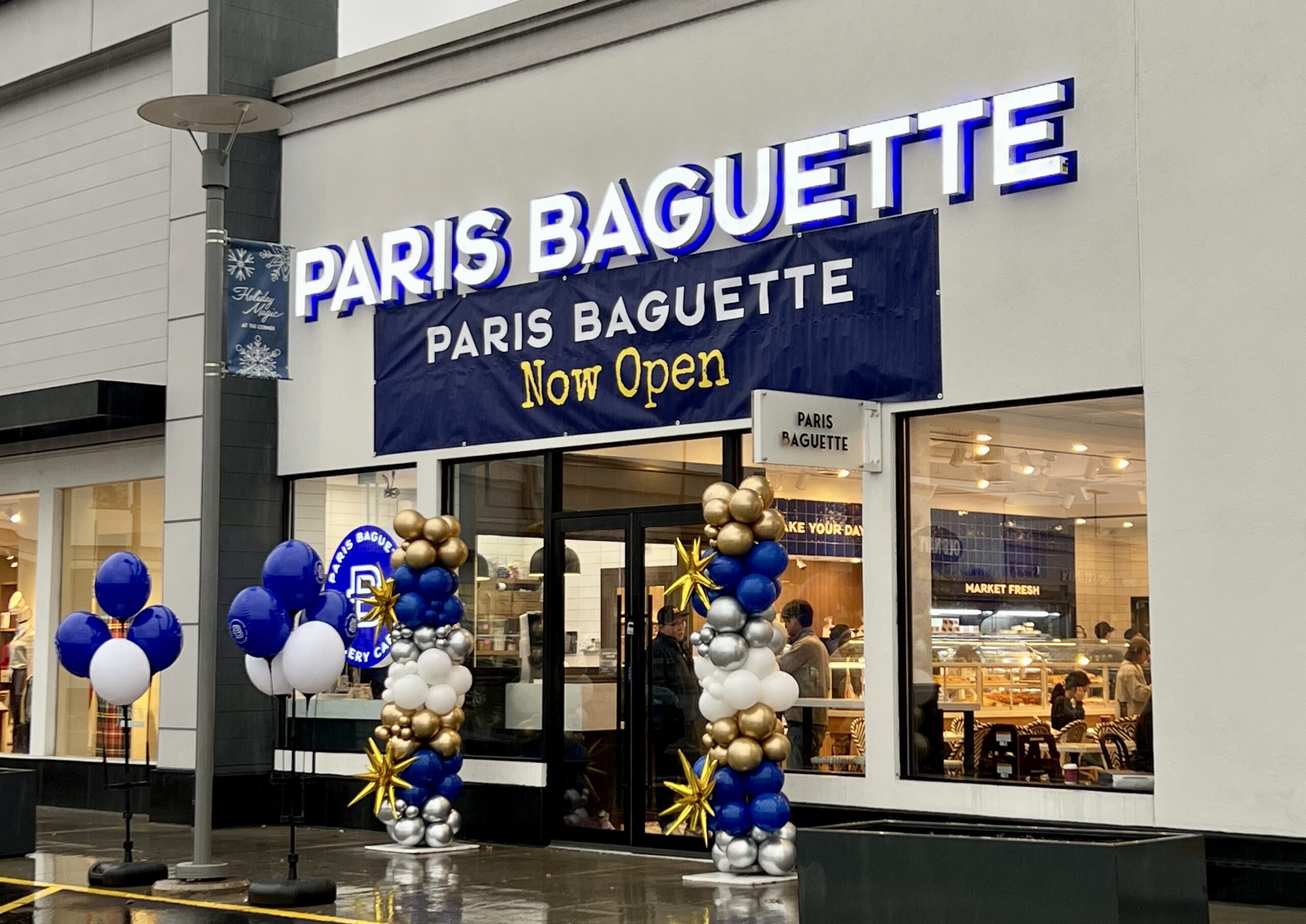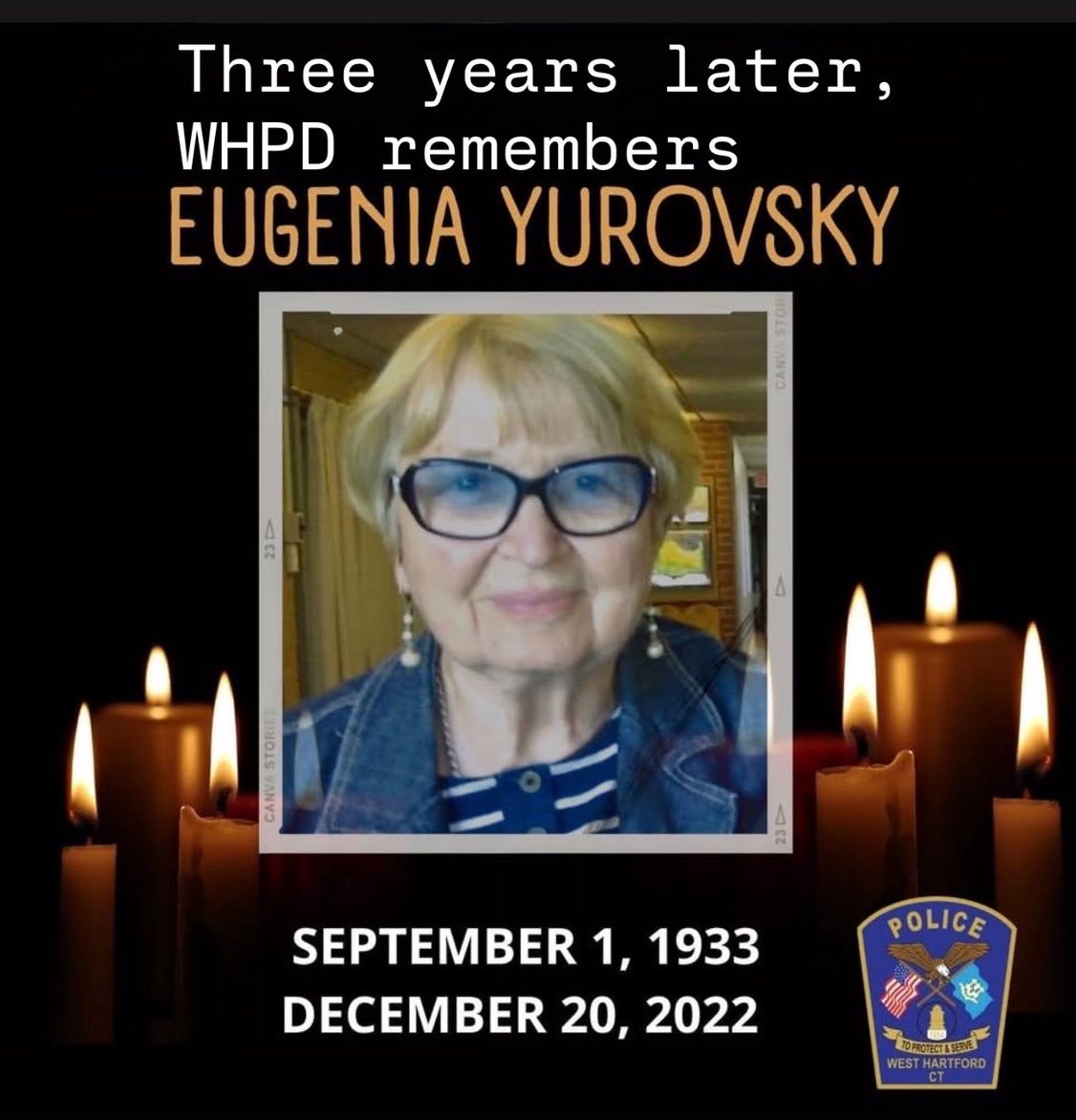From the West Hartford Archives: Beach Park School, Steele Road

Audio By Carbonatix
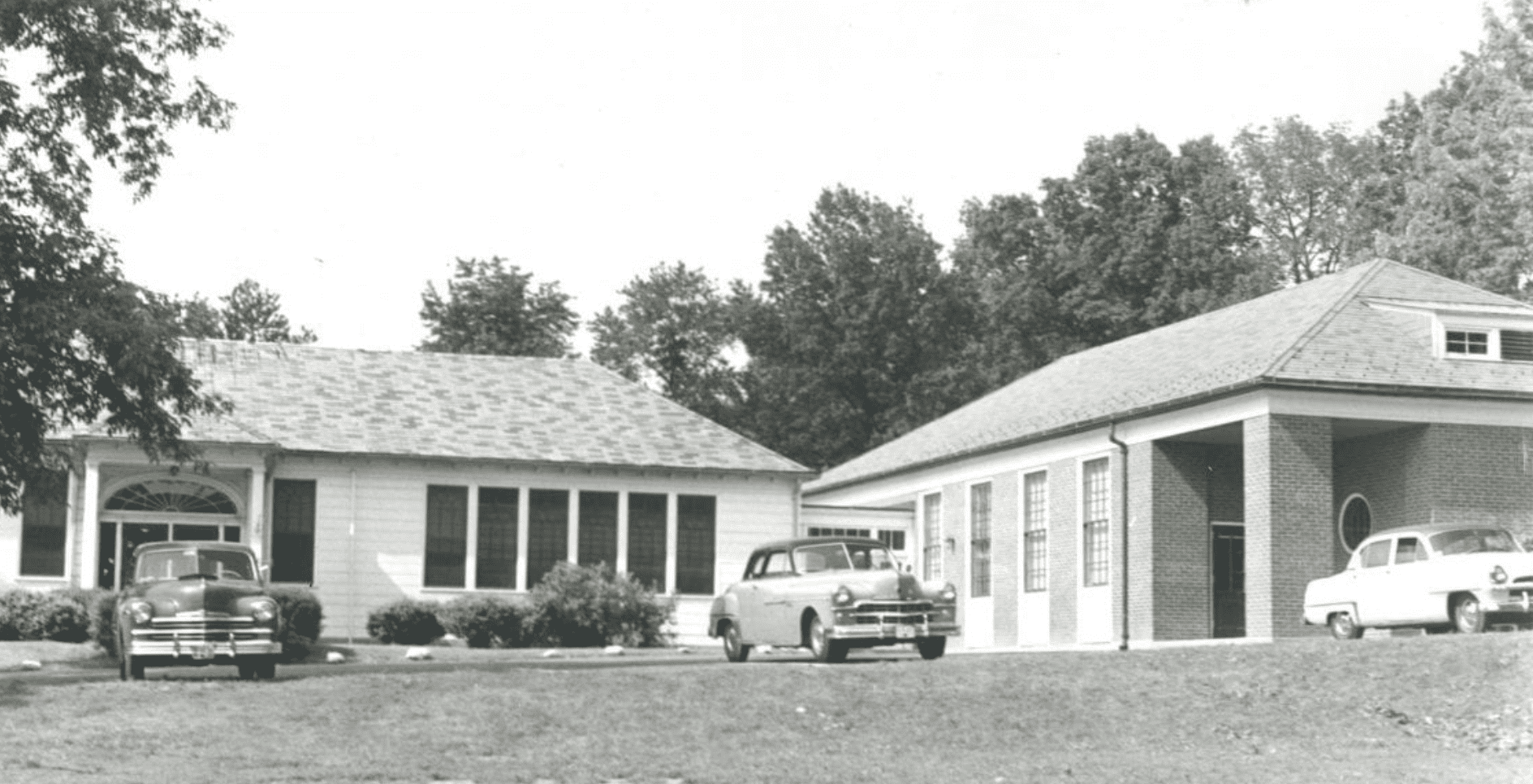
Beach Park School. Courtesy of Noah Webster House & West Hartford Historical Society
Historian Jeff Murray takes a look into West Hartford’s past to uncover some surprising information, stir up some memories, or reflect on how much life has changed – or hasn’t changed at all. Enjoy this week’s ‘From West Hartford’s Archives’ …
By Jeff Murray
The Beach Park School, now the School for Young Children, was built at 238 Steele Road in 1926 just past the northeast corner of Asylum Avenue.
The neighborhood is centered on Steele Road, which according to William Hall formed the eastern line of an ancient family farm and originally was just a narrow street with bushes on each side. There was some speculation that Steele Road may have been an extension of the old Quaker Lane.
It was named after the family of Paphro Steele (1783-1869), whose brick house at 154 Steele Road near Birch Road still stands today. His direct lineage is a gold mine for West Hartford-centric genealogy. Many prominent Griswolds in the Center and around Quaker Lane around the turn of the 20th century could trace back to Steele through his daughter Mary. Another daughter, Cordelia, married Julius F. Phelps, who owned a historic tavern (the Phelps tavern) west of Mountain Road. His son Sherman owned a farm on the corner of Steele and Albany Avenue and Sherman’s granddaughter married a prominent land owner in the Center around the Boulevard. The family connections feel limitless, but they help illustrate how much the town events by 1900 would have felt like a never-ending family reunion.
After Steele’s death in 1869, almost 50 years after the death of his wife, the farm, which extended from Albany Avenue to near Fern Street, was divided among the families of his children. His daughter Martha, a nurse who married William Gaines, came into possession of the brick house on Steele Road and it later was inherited by their son John until many decades later. One would think that Asylum Avenue in West Hartford is older, but in fact Steele Road predates it! In the spring of 1871, Asylum Avenue was extended from the Hartford line through to North Main Street, dividing Steele Road in two.
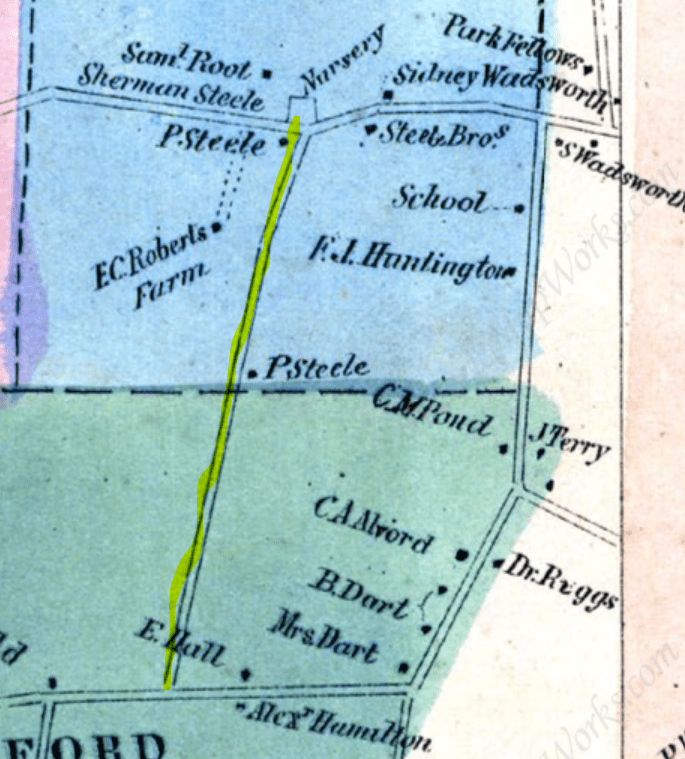
Map of Steele Road in 1869 from Baker & Tilden
The Steeles owned a house at the direct southwest corner of Albany Avenue, but the land surrounding it to the west was a different farm, specifically the birthplace of Rose Terry Cooke, an American author and poet, in 1827. After graduating from the Hartford Female Seminary in 1843, she contributed many short stories and poems to a number of publications. While she moved from West Hartford early in her life, her stories were inspired by New England country life and helped translate the regional culture into a unified voice through her literature for many years until her death.
In 1836, Zephaniah Alden bought the Terry farm and helped double its produce over the following six years, which the newspapers attributed to his efficient use of manure, which was carted from the bottoms of pond holes and from the road side. His son Thomas was one of the two West Hartford prospectors who went west to California in 1849 to cash in on the gold rush.
Just 10 years after Alden sold the farm in 1868, it came into the hands of the Sisters of Mercy, who were originally founded to care for orphans. They had just opened a home school for boys on South Quaker Lane known as Augustine’s Villa and so the house on this property off Steele Road was to be used for a convent building. It opened in October 1880 and expanded its population on this farm over the next 15 years. In 1894-95, after the space was not sufficient anymore, the current St. Mary’s Home for the Aged was built to accommodate about one hundred people. The sisters of the parish used the surrounding 110-acre farm to supply garden produce to Mount Saint Joseph’s Convent. By the time it was built, there were six sisters, 21 aged women, and three men living at the old homestead. Since a few major renovations on the Home within the first few years, the immediate corner has remained essentially the same since then.
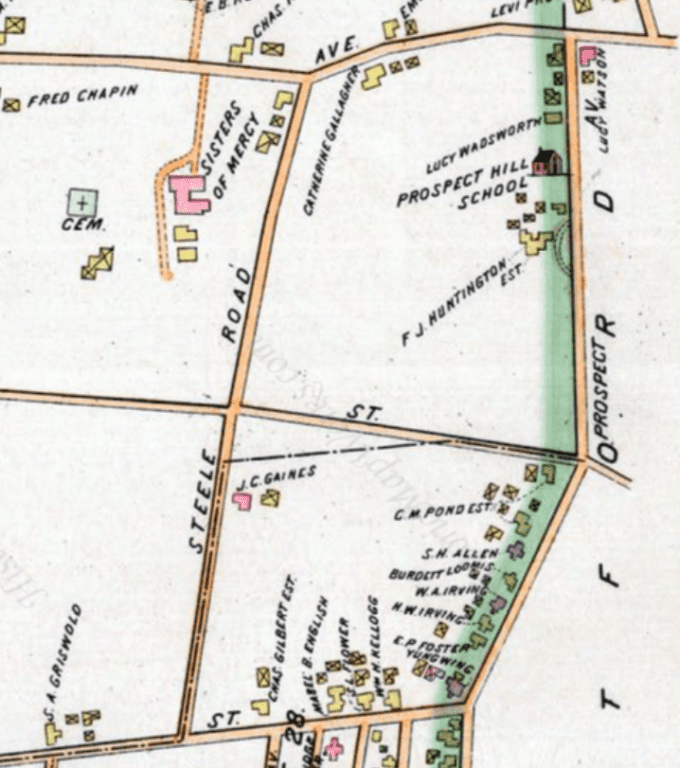
Map of Steele Road in 1896, showing the brick Steele home owned by Paphro’s grandson
Two other major developments along Steele Road and surrounding area in the 1890s set the future course for the neighborhood.
First, the creation of Elizabeth Park helped transform Steele Road from essentially a farm driveway to an outlet for Hartford’s leisure in a suburban environment. This land at the corner of Asylum Avenue and Prospect Avenue was owned originally by Charles F. Pond as a farm in the 1860s. According to William Hall, the western part of the farm, fronting on Steele Road, was a swampy pasture where boys coming home from school would hunt and otherwise hang out. His son, Charles M. Pond, bought up more acreage and improved the property from 1869 to 1874. When he died in 1894, he gifted the land to the City of Hartford for a public park to be named after his wife Elizabeth, who had died before him.
The park was developed in the latter half of the 1890s, but it became a landmark for the changing West Hartford. A stranger placed ten benches at the summit of Prospect Hill so people could enjoy the view of the park. Annual picnics were held by Sunday schools, residents complained about bicyclists, the Grange held picnics on the grounds, and it became an intimate spot for young couples during the day (and after dark).
The second development was the layout of the original golf course for the Hartford Golf Club across the street from Elizabeth Park on the north side of Asylum Avenue. After the club organized in 1896, golf had only recently been introduced to the United States. Open ground was used in the west side of the city, but in 1899, the club purchased 70 acres of land between Albany Avenue and Asylum Avenue and they laid out a course that fall, building a large clubhouse on the north side of Asylum. The atmosphere set by Elizabeth Park definitely contributed to the optimism felt by the 350 club members.
“The view of the city from the holes on the summit at Elizabeth Park has been enhanced by the Indian summer haze hanging over it,” remarked the Hartford Courant on Oct. 21, 1899.
John C. Gaines, the grandson of Paphro Steele, sold an individual lot on Steele Road to James H. T. Brown, a golf instructor, for a house in 1901 – a fascinating connection between the two time periods. Two short roads were laid out north to reach the clubhouse and were named Golf Road (how fitting) and Vardon Road for Harry Vardon, a famous professional golfer who played against the club’s members in 1900. Embarrassingly, Vardon considered it “positively the rottenest course I ever played in my life,” but perhaps the naming of the road in the years after was just a reflection of the growing pains the club had to endure.
After the first few years, the club gained momentum and people pushed for an extension of a trolley line along Prospect Avenue to Asylum Avenue and then to Steele Road, which helped tie together the whole area. This trolley line was later extended to St. Mary’s Home in 1907 from Asylum north, emphasizing just how important this corridor became with these three major developments along Steele Road. As houses began to be built along Prospect Avenue in the Asylum area, activities in the neighborhood diversified, like tennis and squash.
In the winter of 1908, the Curling Club, also a recent arrival in the U.S., flooded one of the courts for a rink. Polo was popular as well. It became an interesting reflection of the social divide between the wealthy Hartford businessmen who settled the neighborhood and frequented the area, and the working-class and people of immigrant backgrounds who tended to work as employees.
The number of jobs also increased from the influx of people in this community – the Hartford Golf Club had groundskeepers, locker stewards, cooks, and waitresses. It made an expansion of the club north and west inevitable and indeed, the current location of the club north of Albany Avenue was the product of this growth.
By World War I, Sycamore Road and Whetten Road were laid out and began to be developed. Their close proximity to the trolley, the park, the club, and the west end of Hartford made them extremely attractive to wealthy families.
The Hartford Golf Club had originally bought the 70-acre piece of land from Charles M. Beach, whose family was prominent in the town. Beach came from a wealthy industrialist family in Hartford and settled near the corner of South Main Street and New Britain Avenue in 1859 for a summer home. The Beach family conducted a dairy farm named Vine Hill where Beachland Park is today, but he also had significant real estate along Prospect Avenue and his children continued the family connection to it. His daughter Harriet married William W. Huntington, whose family lived in New York City but summered in West Hartford along Prospect Avenue. Huntington was involved on the school committee and an officer of St. James’s Church. The land sold to the Hartford Golf Club in 1899 had been from his father’s estate, which he had lived on since his death in 1878 and indeed many of the houses built on Prospect Avenue north of Asylum Avenue were on land that was sold by Charles M. Beach to individual owners, like Robert Schutz, Edith Sumner Simpson, and William S. Brockway.
After he died in 1910, the land went to his son, Thomas Belknap Beach.
It is in this context that the Beach Park School had its origin, albeit very blurry at this point. Thomas lived at 1101 Prospect Avenue at the end of the row of houses his father had sold the land for, and he owned the undeveloped land all the way to the east side of Steele Road. As his father had sold off the lots in the first decade of the 1900s, Thomas sold off the ones where houses would be built along Sycamore Road by World War I, adjoining the Hartford Golf Club property. It is therefore fitting that the street that connected Whetten to Vardon to Golf to Sycamore Road was named Belknap Road in 1914.
With this layout, there was a slice of undeveloped land left between Steele Road and Whetten Road at the corner of Asylum Avenue. In the summer of 1916, Beach donated the lot to the Town of West Hartford for the site of a future school, which was definitely going to be needed with the influx of new residents into the neighborhood. On the same day in June 1923, Beach sold off all his holdings north of this school site up to Albany Avenue – to the Hartford Curling Club for a clubhouse and to the Stratford Company, which would lay out what is now Stratford Road between Steele Road and Whetten Road.
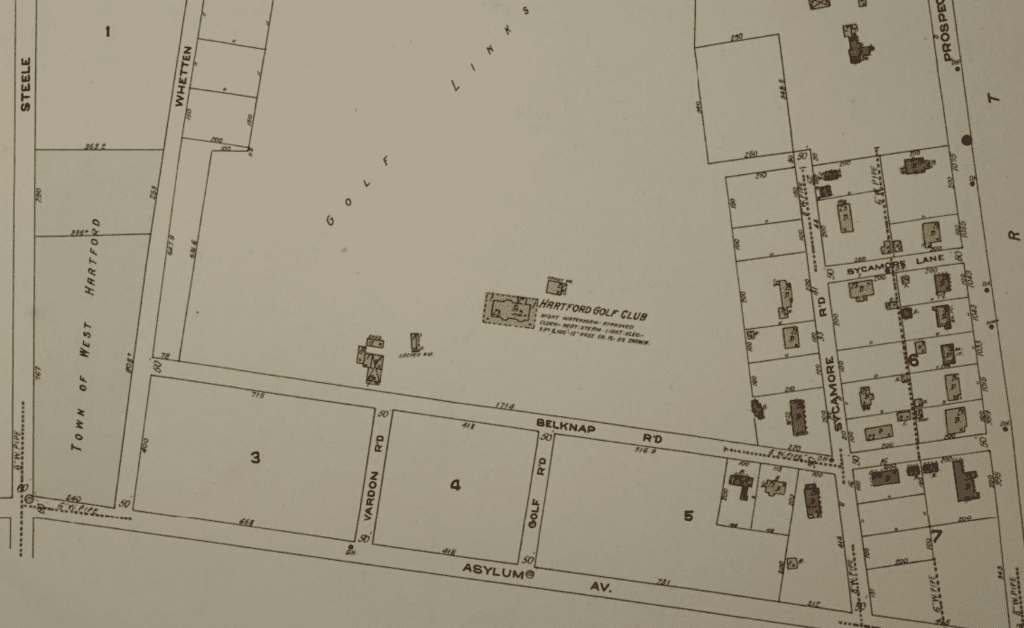
A map of the area in 1923 – the land on which the Beach Park School would be built is on the left and the brick house on a large lot of land in the top right was the Thomas Belknap Beach house.
The population of West Hartford quickly grew after World War I and through the 1920s, and Beach had a condition in the deed of the donated site for the school that it had to be built before 1927, so the town council set out on its construction in the summer of 1925.
Henry A. Wolcott, a member of the school board, said they had worked on plans for the elementary school building since the previous fall to take advantage of that condition. The superintendent of schools during this period was Lloyd Bugbee. Interestingly enough, both Bugbee and Henry Wolcott would be the inspiration for the names of two new elementary schools almost exactly 30 years later.
The Beach Park School opened at 238 Steele Road on March 1, 1926. The school served the community for more than 45 years with an addition in 1931 and 1950. Many people today either attended the school or had parents and grandparents that attended as children, but through the 1960s, enrollment steadily declined in elementary schools across the town.
It was recommended by 1970 that the school be closed and was shuttered permanently in June 1972, despite some pleas for either renovation or restructuring. Some had supported the closing because it was too small to support modern educational programs and was too old, but critics argued for preservation of the community school. Nevertheless, the building was eventually abandoned after its closure and the years went by. In 1999, however, the school building experienced a rebirth and with sufficient funding, it was renovated and converted into a new site for the School for Young Children, which was established by the Sisters of Mercy in 1936 and affiliated with Saint Joseph College. It continues to this day.
The Beach Park School building is a testament not just to our commitment to early education, but also to our enduring connection to the neighborhoods that our children are educated in. It is an unfortunate consequence of this discipline that I have to choose what to discuss and what to table for next time, but maybe providing snapshots that weave together these collective stories is actually better than an exhaustive chronology.
Steele Road became the nucleus of every sector of society in just a few decades and is a perfect representation of the depth that was created in West Hartford over the years. A tight-knit country road occupied by a few generational farming families was subjected to the forces of human nature and was slowly carved into a preserved gateway into this town’s history.
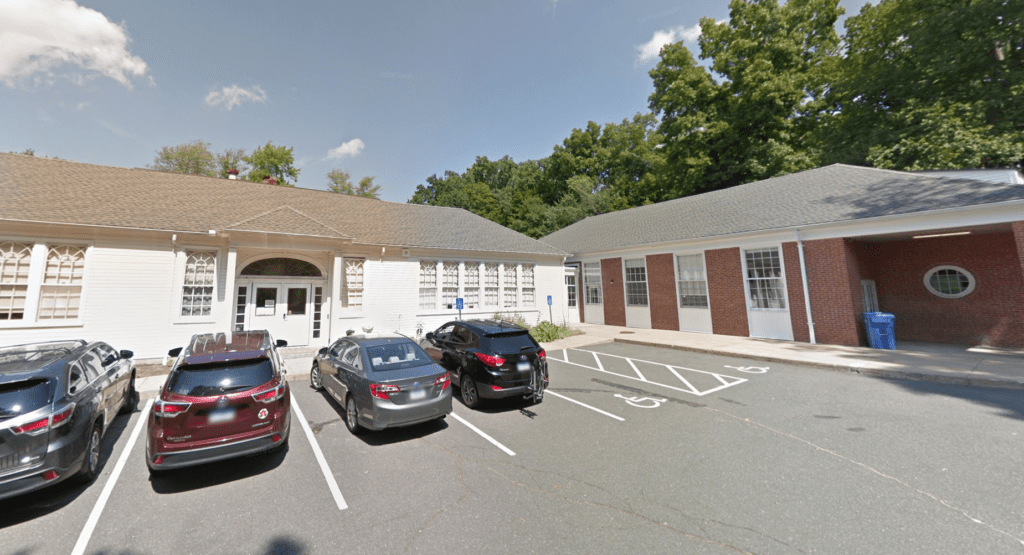
School for Young Children. Google Street view, 2018
Jeff Murray was born and raised in West Hartford and has been involved with the Noah Webster House & West Hartford Historical Society since 2011 when he was a high school student and won the Meyer Prize for his essay on local history. Jeff routinely volunteers as local history researcher uncovering information for numerous museum programs such as the West Hartford House Tour and West Hartford Hauntings. Jeff works as a data analyst at Pratt & Whitney.
Like what you see here? Click here to subscribe to We-Ha’s newsletter so you’ll always be in the know about what’s happening in West Hartford! Click the blue button below to become a supporter of We-Ha.com and our efforts to continue producing quality journalism.


